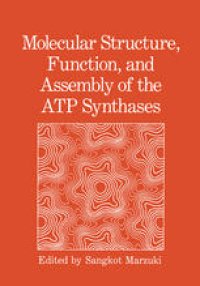
Ebook: Molecular Structure, Function, and Assembly of the ATP Synthases
- Tags: Life Sciences general
- Year: 1990
- Publisher: Springer US
- Edition: 1
- Language: English
- pdf
In recent years, the ATP synthase (H+·ATPase, FoFrATPase) has been the subject of intensive IDvestigations in many laboratories. The major reason for this lies in the fact that this enzyme complex catalyses one of the most important reactions in living cells, namely the synthesis of ATP utilizing the energy from an electrochemical transmembrane H+ gradient, generated by the cellular respiratory chain or by the light reactions of photosynthetic organisms. The mechanism by which the H+ motive force is utilized to drive the synthesis of ATP is one of the major unsolved problems in biochemistry. Thus, the fundamental information concerning the-molecular structure and the mechanism of assembly of the ATP synthase is of major significance in cell biology. A seminar/workshop on the Molecular Structure, Function and Assembly of the ATP synthases was held in April, 1987 at the East·West Center, University of Hawaii, Honolulu, Hawaii, to promote exchange of information between laboratories actively engaged in the study of the A TP synthases, and to provide a forum for discussion and coordination of data derived from molecular, genetic and biochemical approaches used in different laboratories. This volume summarizes the result of the seminar/workshop, in the form of a collection of papers presented at the meeting, and provides an overvIew of current work in this rapidly progressing area of research.
Content:
Front Matter....Pages i-ix
Front Matter....Pages 1-1
Gene Structure and Function of Thermophilic ATP Synthase....Pages 3-8
The Chloroplast Genes Encoding CF0 Subunits of ATP Synthase....Pages 9-18
Expression and Evolution of the Chloroplast ATP Synthase Genes....Pages 19-25
Structure and Expression of Genes Encoding Higher Plant Mitochondrial F1F0-ATPase Subunits....Pages 27-33
Front Matter....Pages 35-42
Biochemical Analyses of oli1 and oli2 Gene Mutations Determining Primary Sequence Changes in Subunits 9 and 6 of Yeast ATP Synthase....Pages 43-43
The Structure and Expression of a Human Gene for a Nuclear-Coded Mitochondrial Adenosine Triphosphate Synthase Beta Subunit....Pages 45-49
Import and Assembly of the Mitochondrial ATP Synthase of Baker’s Yeast....Pages 51-65
Assembly of Yeast Mitochondrial ATP Synthase Incorporating an Imported Version of an F0 Sector Subunit Normally Encoded within the Organelle....Pages 67-72
Front Matter....Pages 73-83
Structure of the Escherichia Coli ATP Synthase from Electron Microscopy Studies....Pages 85-93
Monoclonal Antibodies as Probes of Assembly of the Mitochondrial ATP Synthase....Pages 95-104
The Proton-ATPase of Chromaffin Granules and Synaptic Vesicles....Pages 105-105
A H+-Translocating ATP Synthase in an Extremely Halophilic Archaebacterium....Pages 107-114
Front Matter....Pages 115-128
Structure and Function of Mitochondrial Coupling Factor B(FB)....Pages 129-139
Subunit Arrangement in Bovine Mitochondrial H+-ATPASE....Pages 141-147
Interaction of Regulatory Subunits with the F1 Sector of ATP Synthase in Mitochondria....Pages 149-149
The pKa Gate Mechanism for Protomotive Coupling: Effects of Internal Buffers on Initial Rates of ATP Synthesis....Pages 151-161
ATP Synthesis Driven by Intramembranal Protons....Pages 163-172
Front Matter....Pages 173-180
Catalysis by Isomeric Forms of Covalently Labeled F1-ATPase....Pages 181-193
Catalytic and Noncatalytic Nucleotide Binding Sites of F1-ATPases: Probes of Location, Structure and Function by Use of 2-N3-ATP....Pages 195-203
Interaction of Arylazido-?-Alanyl ATPa with the ATPase Enzyme of Rhodospirillum Rubrum Chromatophores....Pages 205-205
On the Number of Catalytic Sites in the F1-ATPase that Catalyze Steady State ATP Hydrolysis....Pages 207-217
The Effects of Neutral Salts and Nucleotides on the Stability of Beef Heart Mitochondrial F1-ATPase....Pages 219-228
A Hydrophobic Protein, Chargerin II, Purified from Rat Liver Mitochondria is Encoded in the Unidentified Reading Frame A6L of Mitochondrial DNA....Pages 229-237
Back Matter....Pages 239-249
....Pages 251-258